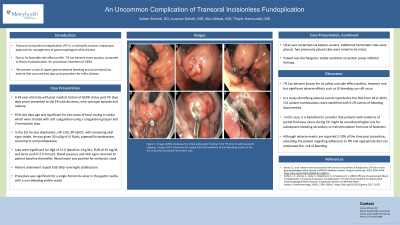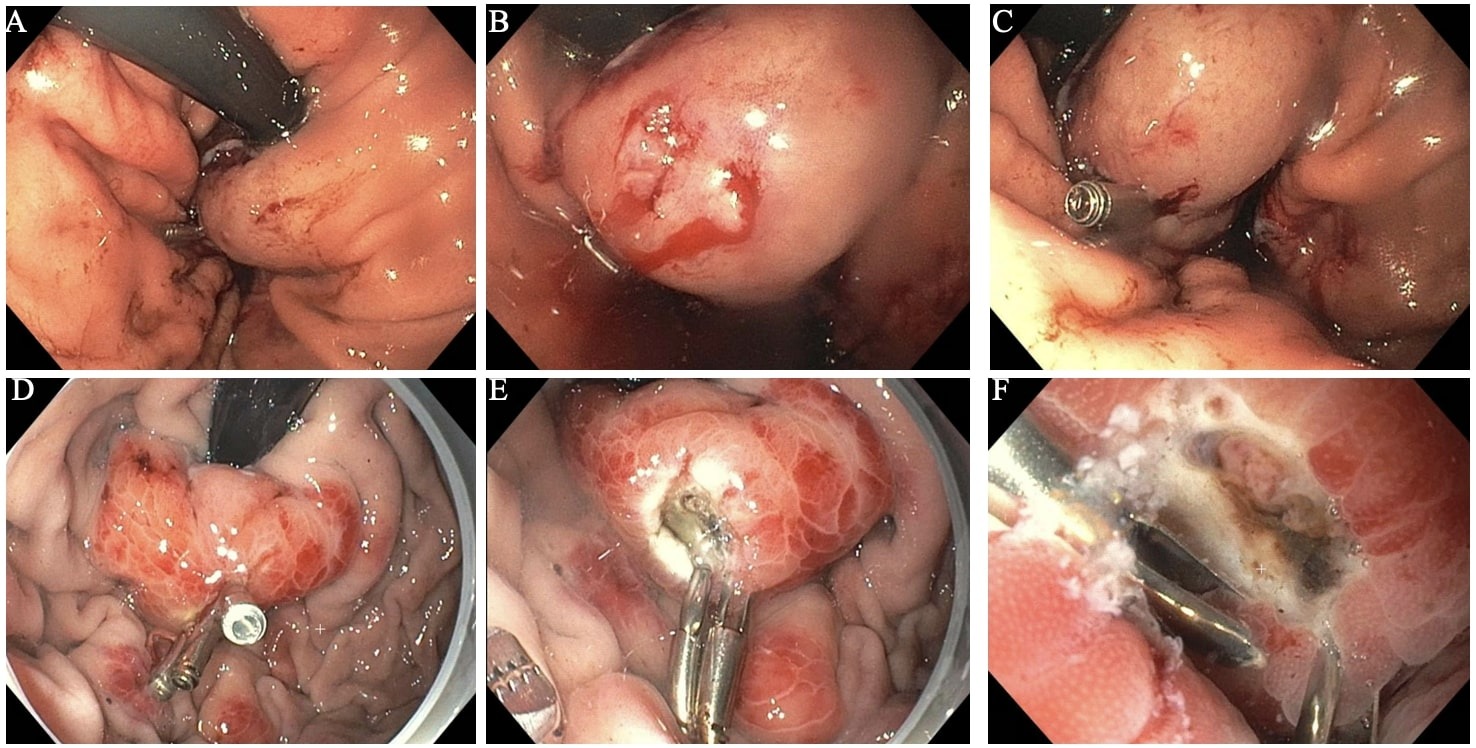Sunday Poster Session
Category: GI Bleeding
P0786 - An Uncommon Complication of Transoral Incisionless Fundoplication
Sunday, October 27, 2024
3:30 PM - 7:00 PM ET
Location: Exhibit Hall E

Has Audio
- SA
Sultan Ahmed, DO
Mercy Health
Rockford, IL
Presenting Author(s)
Sultan Ahmed, DO, Luqman Baloch, MD, Abu Fahad Abbasi, MD, Thayer Hamoudah, MD
Mercy Health, Rockford, IL
Introduction: With advancement in technique, transoral incisionless fundoplication (TIF) has been increasingly favored for the procedural management of gastroesophageal reflux disease (GERD). Performed endoscopically, TIF has favorable recovery profiles when compared to laparoscopy. Common side effects include dysphagia and belching, with perforation being a rare event. We present a case of upper gastrointestinal bleeding that occurred two days post TIF for reflux disease.
Case Description/Methods: A 39-year-old male with past medical history of GERD presented to the emergency room with dizziness, presyncope and melena two days after undergoing TIF procedure. In the ED, he was diaphoretic, HR 110s, BP 60/37, with remaining vital signs stable. He was given 30 cc/kg of IV fluids, piperacillin-tazobactam, vancomycin and pantoprazole. Labs were significant for Hgb of 12.6 (baseline 14 g/dL), BUN of 34 mg/dL and lactic acid of 2.5 mmol/L. Vitals stabilized after resuscitation. Rectal exam was positive for melanotic stool. Patient was given 2 units of packed red blood cells, continued on IV fluids and pantoprazole drip. Upon review of op note, TIF two days prior was significant for two areas of focal oozing in cardia which were treated with soft coagulation using a coagulation grasper and 2 hemostatic clips. After stabilization, patient underwent repeat EGD which was significant for a single Forrest IIa ulcer in the gastric cardia with a non-bleeding visible vessel. This was cauterized via bipolar cautery. Additional hemostatic clips were placed. Two previously placed clips were intact. Patient was discharged in stable condition on pantoprazole therapy.
Discussion: TIF has become known for safety and favorable side effect profiles. However, rare but significant adverse effects such as GI bleeding can still occur. From 2011-2021, 131 patient complications were identified with 9.2% events of bleeding documented [1]. In this case, the evidence of Forest class IIa ulcer noted during the patient’s TIF may have posed a higher risk for subsequent bleeding. Although the side effect profile of TIF procedures is favorable, educating the patient of their individual risk profile and adherence to PPI can potentially help lower the risk of bleeding.
1. Ramai, D., et al. Adverse events associated with transoral incisionless fundoplication (TIF) for chronic gastroesophageal reflux disease: a MAUDE database analysis. Surgical endoscopy, 36(7), 4956–4959. https://doi.org/10.1007/s00464-021-08851-x

Disclosures:
Sultan Ahmed, DO, Luqman Baloch, MD, Abu Fahad Abbasi, MD, Thayer Hamoudah, MD. P0786 - An Uncommon Complication of Transoral Incisionless Fundoplication, ACG 2024 Annual Scientific Meeting Abstracts. Philadelphia, PA: American College of Gastroenterology.
Mercy Health, Rockford, IL
Introduction: With advancement in technique, transoral incisionless fundoplication (TIF) has been increasingly favored for the procedural management of gastroesophageal reflux disease (GERD). Performed endoscopically, TIF has favorable recovery profiles when compared to laparoscopy. Common side effects include dysphagia and belching, with perforation being a rare event. We present a case of upper gastrointestinal bleeding that occurred two days post TIF for reflux disease.
Case Description/Methods: A 39-year-old male with past medical history of GERD presented to the emergency room with dizziness, presyncope and melena two days after undergoing TIF procedure. In the ED, he was diaphoretic, HR 110s, BP 60/37, with remaining vital signs stable. He was given 30 cc/kg of IV fluids, piperacillin-tazobactam, vancomycin and pantoprazole. Labs were significant for Hgb of 12.6 (baseline 14 g/dL), BUN of 34 mg/dL and lactic acid of 2.5 mmol/L. Vitals stabilized after resuscitation. Rectal exam was positive for melanotic stool. Patient was given 2 units of packed red blood cells, continued on IV fluids and pantoprazole drip. Upon review of op note, TIF two days prior was significant for two areas of focal oozing in cardia which were treated with soft coagulation using a coagulation grasper and 2 hemostatic clips. After stabilization, patient underwent repeat EGD which was significant for a single Forrest IIa ulcer in the gastric cardia with a non-bleeding visible vessel. This was cauterized via bipolar cautery. Additional hemostatic clips were placed. Two previously placed clips were intact. Patient was discharged in stable condition on pantoprazole therapy.
Discussion: TIF has become known for safety and favorable side effect profiles. However, rare but significant adverse effects such as GI bleeding can still occur. From 2011-2021, 131 patient complications were identified with 9.2% events of bleeding documented [1]. In this case, the evidence of Forest class IIa ulcer noted during the patient’s TIF may have posed a higher risk for subsequent bleeding. Although the side effect profile of TIF procedures is favorable, educating the patient of their individual risk profile and adherence to PPI can potentially help lower the risk of bleeding.
1. Ramai, D., et al. Adverse events associated with transoral incisionless fundoplication (TIF) for chronic gastroesophageal reflux disease: a MAUDE database analysis. Surgical endoscopy, 36(7), 4956–4959. https://doi.org/10.1007/s00464-021-08851-x

Figure: Figures 1A/1B showcase the cardia retroflexed in the initial EGD w TIF. Figure 1C showcases the ulcer from the initial EGD s/p hemostatic clip placement. Figure 1D/1E/1F showcase the ulcer in the second EGD which was addressed with coagulation grasper and closed with 1 clip.
Disclosures:
Sultan Ahmed indicated no relevant financial relationships.
Luqman Baloch indicated no relevant financial relationships.
Abu Fahad Abbasi indicated no relevant financial relationships.
Thayer Hamoudah indicated no relevant financial relationships.
Sultan Ahmed, DO, Luqman Baloch, MD, Abu Fahad Abbasi, MD, Thayer Hamoudah, MD. P0786 - An Uncommon Complication of Transoral Incisionless Fundoplication, ACG 2024 Annual Scientific Meeting Abstracts. Philadelphia, PA: American College of Gastroenterology.
